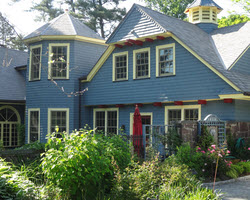No matter where you live, rain, sun, snow, and wind all take a toll on the exterior of your home. A well-applied paint job is the first line of defense for protecting your home against the elements. With summer just around the corner, it is prime painting season with plenty of nice weather to accommodate your projects. However, just because it is a nice sunny day outside does not mean that it will make for good painting conditions. Follow these tips for planning and completing a successful exterior paint job:
Consider the Weather: Check your local weather forecast prior to starting a paint job. It may look beautiful out, but a summer storm can pop up at anytime. Rain and wind can completely sabotage a paint project.
Paint in Optimal Temps: Excessive heat or humidity can ruin a painting project just as much as inclement weather. Hot weather can equal hot painting surfaces, which will result in your paint not adhering properly or it can begin to bubble. Optimal painting temperatures are between 50 and 85 degrees. If you must paint in hot weather, plan ahead and use the sun to your advantage by painting the areas in the shade as the sun moves to avoid direct sunlight. You can also consider using 10% more paint thinner to give yourself more time before the paint dries in hot weather.
Choose the Right Paint: This is an essential part of having a successful and long-lasting paint job. Latex paints are very do-it-yourself friendly. Exposure to sunlight and UV rays causes paint to fade and lose its original tint, but latex paints tend to hold up against the sun better than oil-based paints. Latex paints also allow moisture to vaporize and escape when used on wood surfaces before the moisture has a chance to damage the wood fibers. Acrylic latex paints are the best choice if you have a mixed climate, and go through a heavy seasonal change from cold to hot.
Wash your Siding: Aluminum or vinyl siding is often very chalky or dirty, so give it a thorough power washing or hand scrubbing prior to painting.
Spray the Paint: Paint sprayers can work wonders and drastically reduce your project time as well as give a great finish coat. Siding usually has its imperfections and dings, so in order to hide those consider using a satin or low-luster sheen of paint.
Go Dark on Vinyl: Vinyl siding can begin to warp and buckle from direct sunlight and heat. This is where color choice comes in to play. Dark colors naturally absorb more heat than lighter colors, so a dark colored paint may be in your best interest when it comes to vinyl siding.
Now that you’ve got the essential info for your outdoor painting project, start planning your timeline and supplies, and get out there to paint. Not up to the challenge of exterior painting? Contact the Spring Valley Painters at CertaPro at 845-675-7686.




